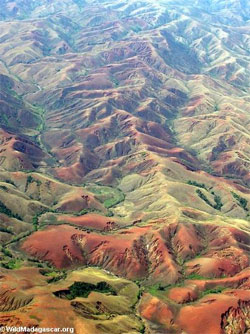Climate change will worsen species extinction in South America
Climate change will worsen species extinction in South America
Rhett A. Butler, mongabay.com
February 28, 2007
The combination of rising levels of carbon dioxide and increasing deforestation could reduce biodiversity in the tropical forests of Northern South America, reports a study published in the current edition of the journal Global Ecology and Biogeography.
Modeling future ecosystem structure, distribution of precipitation, and land use, Dr. Paul A. T. Higgins says the conditions currently favorable for species richness in the Guiana Shield region of South America, one of the world’s most biodiverse areas, disappear as CO2 levels rise and shift rainfall patterns. In the absence of land-use change, this loss would likely be offset by increasingly favorable climate conditions in eastern Brazil — currently a dry region. However, notes Higgins, widespread modification of ecosystems in Eastern Brazil precludes this development, producing an overall net reduction in biological richness in the region.
“Human activities will alter current configurations of land use and climate throughout the world,” writes Higgins, a biologist at Stanford University and the University of California, Berkeley. “For species richness, new configurations are likely to include both positive and negative combinations of climate and land use.”

Land use change will make it more difficult for species to adapt to global warming. |
“Past extinctions are irreversible, however, at least on timescales relevant to human activities. As a result, historical land-use patterns act as a sieve for species richness: once gone a species (or population or individual) cannot return. This reduces the potential gains from favourable recombinations in climate and land-use patterns relative to the unmitigated losses that can occur from damaging recombinations like that shown here for northern South America,” he continues. “Furthermore, transient climate changes amplify the potential danger of reconfiguring climate and land-use patterns as even a temporary restriction of favourable climate to areas heavily disturbed by land use would act as a bottle neck for the long-term survival of some species. As a result, the irreversibility of extinctions due to land-use patterns loads the dice against biodiversity when climate changes.”
Extrapolating at the global scale, Higgins says the results suggest that “climate change and land-use patterns will be likely to interact to reduce species richness.”
He says that migratory barriers like urban and agricultural areas will make it more difficult for species to respond to climate change as they would have in the past.
Higgins is also a Senior Policy Fellow at the American Meteorological Society in Washington, DC.
CITATION: Paul A. T. Higgins (2007). Biodiversity loss under existing land use and climate change: an illustration using northern South America. Global Ecology and Biogeography, (Global Ecol. Biogeogr.) 16, 197—204
Related article
Global warming could trigger 8-degree temperature rise in Amazon rainforest
Tuesday the Brazilian government announced the release of a series of scientific studies, including one by the national space agency (INPE) that projects a 4 to 8 degree-Celcius rise in temperatures in the Amazon Basin by 2100 if nothing is done to combat global climate change.
More news on Brazil and the Amazon